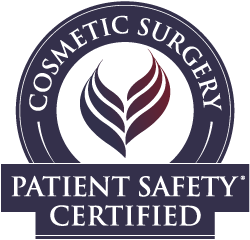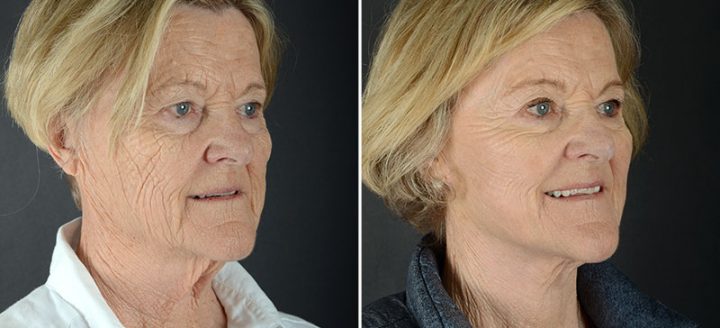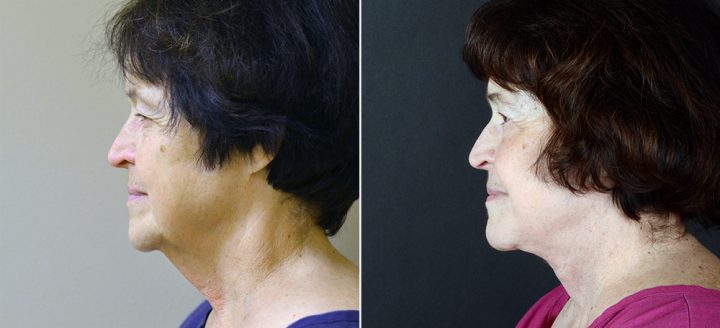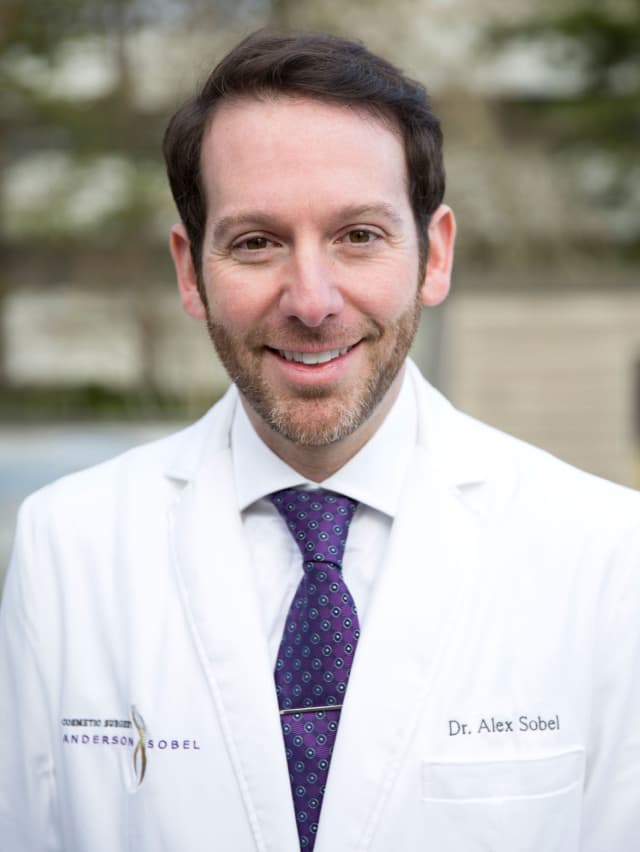Facelift (rhytidectomy)
If you’re concerned about visible signs of aging on your face, it may be time to consult with a board certified cosmetic surgeon about rhytidectomy, commonly known as facelift surgery. As you get older, everything starts to sag and have loose skin. This contributes to the old and tired look that most of us have as we approach middle-age. The facelift tightens certain areas of the face like the eyebrows, jawline and chin, giving you a perkier and more alert appearance. This can erase signs of aging, and unlike Botox, it’s permanent.
Triple-board certified Bellevue cosmetic surgeon Dr. Alex Sobel has performed thousands of cosmetic procedures for patients at his Bellevue cosmetic surgery center. Individual skin type, bone structure, age, and skin elasticity are all carefully analyzed during your complimentary consultations and Dr. Sobel will work closely with you to design a customized treatment plan that best suits your natural anatomy and desired results.
- Triple board-certified in general cosmetic surgery, facial cosmetic surgery, and otolaryngology
- 15+ years of experience specializing in cosmetic surgery
- Operates in an on-site accredited surgical suite for patient safety and privacy
- National leader in cosmetic surgery, including as Past President of the American Board of Cosmetic Surgery and the American Academy of Cosmetic Surgery, and as an expert speaker at medical conferences
- Former Seattle Met Top Doctor with hundreds of 5-star patient reviews
Ensuring your safety during a facelift
Choosing to have cosmetic surgery is a very personal decision—and it’s important that you feel safe, comfortable, and confident with the surgeon and practice you choose. At Anderson Sobel Cosmetic Surgery, we are fully committed to your safety and comfort.

Because a facelift is an incredibly nuanced surgical procedure, it’s critical that patients choose a doctor who operates in a surgery center with hospital-level safety measures in place. You and your family can rest assured knowing that our private Bellevue surgery center is accredited by the Washington State Department of Health (WADOH). Our fully-equipped surgical suite is well-appointed with your safety and comfort in mind.
In addition, Dr. Sobel is Cosmetic Surgery Patient Safety® certified by the American Board of Cosmetic Surgery.

Am I a good candidate for a facelift?
The best candidates for a facelift (versus a non-surgical alternative) have sagging skin that can easily be pinched and pulled away from the face and neck. That’s because the facelift procedure removes extra skin—something which simply can’t be done via any other method.
We typically recommend a facelift if a patient has one or more of the following concerns:
- Loose or sagging skin under the chin or on the neck
- Visible jowling along the jawline
- Deep folds along the sides of the nose or mouth
- Moderate to severe skin laxity or sagging in the cheeks
“Wow fabulous doctor. Don’t hesitate… Facelift & necklift superb!!! Look 15 years younger!
Additional facial rejuvenation procedures
If a heavy, wrinkled brow is weighing down your look, a brow lift can help smooth away visible signs of aging and reposition your brow to a more youthful position.
If you are mainly seeing signs of aging in the mid portion of the face—sagging in the cheeks and prominent nasolabial folds—a less invasive mid-facelift may be an appropriate option.
If facial wrinkles are your top concern (but you have minimal skin sagging), Botox (for the upper ⅓ of the face) and fillers or fat grafting (for the bottom ⅔ of the face) are often a more effective wrinkle treatment than facelift surgery. In fact, we frequently incorporate these non-surgical treatments into our facelift patients’ treatment plan for this purpose: the facelift addresses the sagging, the injectables take care of the wrinkles and volume loss.
Additionally, many patients come in thinking they need a facelift procedure, when volume loss is the main problem—a problem that can be remedied with injectable fillers or facial fat transfer. As you can probably see, the only way to determine with certainty which facial procedures will be best for you is to book a consultation with an experienced facial cosmetic surgeon.
- Key Benefits
- Glossary
- Reduced Sagging and Tighter Skin: One of the primary benefits of a facelift is the reduction of sagging skin. Facelifts effectively tighten the skin, giving the face a smoother, more youthful appearance.
- Minimized Wrinkles and Fine Lines: Facelifts can significantly diminish the appearance of wrinkles and fine lines, particularly around the lower face and neck.
- Corrected Jowls: A facelift can effectively correct jowls, which are sagging areas of skin and fat around the jawline, restoring a more youthful jawline and chin profile.
- Tightened and Toned Neck: The procedure can also address issues in the neck region, such as loose skin and excess fat, leading to a more toned and youthful neck appearance.
- Long-Lasting Results: Compared to non-surgical treatments, the results of a facelift are more significant and long-lasting, often lasting for several years.
- Anesthesia: Medications used during surgery to relieve pain and alter consciousness. For facelifts, this can include local, twilight, or general anesthesia.
- Blepharoplasty: A surgical procedure to improve the appearance of the eyelids. Often performed in conjunction with facelifts.
- Collagen: A protein that provides structure to the skin. Collagen production decreases with age, leading to wrinkles and sagging skin.
- Deep Plane Facelift: A technique that involves repositioning the entire facial structure, including muscles, fat, and skin, for a more comprehensive rejuvenation.
- Elastin: A protein in connective tissue that allows skin to resume its shape after stretching or contracting. Like collagen, it decreases with age.
- Facelift (Rhytidectomy): A cosmetic surgical procedure to create a younger appearance by reducing sagging or folds of skin on the cheeks and jawline.
- Hematoma: A collection of blood outside blood vessels, often in liquid form within the tissue. This is a potential complication of facelift surgery.
- Incision: A cut made during surgery. In facelifts, these are typically made around the hairline or ears to minimize visible scarring.
- Jowls: Sagging skin below the chin or jawline, often targeted in facelift procedures.
- Keloid Scar: A thick, puckered, itchy scar that may form at the site of a surgical incision. Some individuals are prone to this type of scarring.
- Laser Resurfacing: A procedure often used in conjunction with facelifts to improve skin texture and appearance by removing layers of skin.
- Mini-Facelift: A less invasive version of a traditional facelift, focusing on the lower face, particularly the jawline and neck.
- Neck Lift: A surgical procedure to improve visible signs of aging in the neck area, often performed alongside a facelift.
- Otoplasty: Ear surgery, which can be performed for cosmetic reasons and is sometimes considered with facial aesthetic procedures.
- Rhytidectomy: The medical term for a facelift, focusing on removing or reducing wrinkles and sagging skin caused by aging.
- SMAS (Superficial Musculoaponeurotic System): A layer of tissue deep within the skin and subcutaneous tissue, often repositioned during a facelift for more lasting results.
- Tumescent Technique: A technique involving the injection of a large volume of a diluted local anesthetic. It is used in various cosmetic surgeries for minimizing blood loss and providing pain relief.
- Volume Loss: A term referring to the loss of facial volume due to aging, often addressed in facelift procedures through fat grafting or fillers.
How much does a facelift in Seattle cost?
At our office in Bellevue, facelift surgery costs between $6,500 and $13,000. If this seems wide to you, that’s because individual facelift patient needs and goals vary significantly. The price of a facelift in Seattle depends on the extent of the procedure needed to reach your desired goals. If you are interested in combining multiple cosmetic procedures and would like to get a general idea of the total cost, you can use our mix & match pricing tool. Please note that these prices are ballpark estimates, and can vary based your individual surgery plan.
After your free consultation with Dr. Sobel, you will be provided with a detailed fee quote for your consideration. We are happy to answer any questions you may have about paying for your cosmetic surgery, and we also have financing options available.
Funding your facelift procedure
We believe everyone should have access to cosmetic medicine, and we therefore strive to make payment for services clear and easy. We have partnered with companies that offer convenient financing solutions for patients by providing extended financing options, low monthly payments, and convenient customer service. If you would like to apply for financing, please contact our office to get started! It’s very easy to apply!
What to Expect During Facelift Surgery
On your day of your procedure, you will have the choice of local anesthesia, oral relaxation medications, IV sedation, or general anesthesia at Dr. Sobel’s Washington State licensed surgical suite in Bellevue. Dr. Sobel will make incisions in as inconspicuous a location as possible to reduce visible scarring after you have healed. For women, facelift incisions are placed in the natural creases of the skin for minimal visibility and are concealed within the ear itself. For men, incisions are placed so that we can remove excess skin and tighten tissues without disturbing the natural beard line.
Video transcript
The evolution of facelift procedures and treating the aging face in my practice over the past 15 years has been one of the most satisfying aspects of my work in cosmetic surgery. I was educated and trained during my fellowship on aging face procedures. What I brought initially to the table was being a good technician; I could execute the operations very well. However, over time, I learned the importance of better patient selection, particularly considering the incredibly diverse armamentarium of procedures that now exist. The reason there are so many different procedures is that no single approach works for everyone.
Circa 2007, the operative plan for someone concerned about sagging skin was to lift everything. This included brow lifts, mid facelifts, lower facelifts, neck lifts, eyelid procedures, and smoothing everything out with resurfacing—then repeat for every patient. However, contemporary facelift procedures in my practice are very much tuned to the specific concerns that identify age for that patient in the mirror.
That may mean, in a heavier-set neck, a patient who has never liked the appearance of their neck, from age 18 to 71, may need a deep plane facelift because that is the right procedure for their neck. Whereas someone who has always enjoyed a sculpted neck but has developed some muscle banding, lines, and mild skin laxity, would not benefit from a deep plane neck lift. In such cases, a mini lower facelift is a much more appropriate procedure.
Video transcript
In discussing the topic of deep plane face lifting at a very superficial level, it may sound like we simply peel back the deeper layer of SMAS and address it in a more intentional, and perhaps more aggressive, way. But that’s not actually what’s happening. In the deeper plane, we gain access to certain tissues that interact between the top layer and the deep layer. Key areas where this occurs include the cheek and midface. There are a few ways to address this. However if it’s skin only, we get this kind of appearance where the lateral canthus, or outer portion of the eyes, is pulled upward, which never looks natural. Using that maneuver as a surrogate to try to move the upper jowls is just a bad idea. However, in a deeper plane, the suspensory ligaments that tie this portion of the middle layer of SMAS to the bone—that can be lifted and repositioned without lifting the outer corner of the eye.
During your facelift procedure, Dr. Sobel will reposition and tighten underlying muscle and connective tissue to restore the underlying corset that supports the face and neck. The resulting excess skin is then removed and remaining skin is tightened. After the incisions have been closed, you may be driven home the same day by a family member or friend. For our out-of-state guests, we have arrangements with hotel, nursing, and transfer services to accommodate a variety of needs and desires.
Most of our patients report very little discomfort after surgery, but medication will be prescribed to alleviate any pain. Dr. Sobel uses ample amounts of local anesthetic even while his patients are asleep for their maximal comfort upon waking. Some swelling and bruising are to be expected and may be minimized by sleeping with the head of the bed elevated and taking frequent walks. Dressings will be removed at a follow-up examination in one to two days. All sutures are removed between five to ten days following surgery.
Facelift Recovery
Because it is a fairly intensive surgical procedure, recovery following a facelift does take a bit of time while your muscles and skin heal. Depending on the extent of your procedure, plan to take one to two weeks off work. If you have young children, it is important to prepare for their care in addition to your own during this time.
Video transcript
One of my favorite mentors early in my training career pulled me aside and said, “Alex, you’re going to need to read chapters and chapters about face lifting before you understand the word salad, the language that’s wrapped around facelifts.” Early on, as facelifts evolved from skin-only techniques, a number of great surgeons distinguished themselves in the academic community by the type of face lifting they were doing. Terms like “deep plane” and “composite plane” were initially coined but then evolved over time, as they should, because the procedures needed to evolve. Deep plane procedures, at their very heart, address structures that are obviously in a deep plane. Well, what does that mean? There’s a suspensory—or a “Saran Wrap,” if you will—layer of your face underneath your skin that holds everything up. Underneath that layer, the SMAS layer, are suspensory tissues that are tied to bony coverings and have interrelations that afford some flexibility in lifting procedures that you don’t have access to if you’re just on the layer above the “Saran Wrap.” Of course, everybody’s known that for a long time. Yet, of course, enter surgeons who are— forgive me—a bit prideful, but who want to distinguish themselves not just among their colleagues when they’re talking to each other at meetings, but also amongst clients. They ask, “How is their facelift different than the others?” What I love to discuss in my practice is how to disassemble all of that, parse the facelift procedure into the parts, and talk about what each of those maneuvers does really well for that patient in particular.
Video transcript
Recovering from facelift procedures is primarily social. These procedures are gentle, and patients can return to work in three to four days, but I ask them if they really want to. Gone are the days when we wrap patients all up in giant Q-tip gauze-type stuff. However, there is a real social imposition if you’re wearing a spandex wrap on your face for a few days. You may have some swelling, some bruising, and some sutures that are going to come out really soon. If you don’t feel comfortable sharing those with colleagues, then stay home for a couple of weeks.
The most immediate concern many patients have is about discomfort following their facelift surgery. I use tumescent technique in addition to the patient’s chosen level of sedation for maximal comfort during and after surgery. Most of my patients are off narcotic pain medication within 72 hours. Driving can resume after approximately three or four days assuming the patient is no longer taking medication. The key to knowing whether patients are ready to drive is ensuring they can turn the head from side to side in order to safely check blind spots when behind the wheel.
Swelling and bruising increases daily for the first several days following the procedure. Around the fifth day, these symptoms will begin to subside. Approximately one week after the surgery, most patients will have little swelling or bruising left in the face and neck area. Patients can begin wearing makeup at this point in time as well.
Patients should plan on waiting approximately one to two weeks before getting back to pre-surgery social calendars. This will allow enough time for the body to heal. With the help of the right hairstyle or hair cut, plus the use of makeup, many patients can cover signs of the procedure at this point.
When it comes to patients getting back to their full physical routines, including things like exercising and heavy lifting around the home, the typical recommendation is approximately three weeks. It is a good idea for patients to give themselves a full three-week period for a complete facelift recovery. In some cases, patients may experience some numbness for several weeks or months after that.
Recovery following cosmetic surgery can be an incredibly emotional process. Just as you should prepare yourself for your physical recovery, you should likewise have an idea about what to expect emotionally and mentally as your body heals and your final results take shape.
“Today, many individuals mistake me for a much younger man which is fine with me. Yes, my life has been better with the confidence of knowing I have now have a youthful, happy face and it’s all thanks to Dr. Sobel and his excellent staff.”
Facelift Results
The final result of a facelift is a firmer, younger appearance to the lower face, jawline, and neck areas. Though individual results may vary, patients report increased self-confidence in addition to the rejuvenating effects of their facelift procedure. If you are looking for more dramatic improvement to the areas around the eyes, Dr. Sobel may recommend combining your Seattle facelift with an eyelid lift to enhance results.
It’s important to understand that while your results will look great within two to four months after surgery, they won’t be final for up to one year. Fortunately, the most dramatic changes occur in the first few months and are subtle thereafter.

View more results in our gallery
Dr. Sobel has performed thousands of facial cosmetic surgeries on happy patients in the Seattle area. To view real patient transformations and see what kind of results you can expect from breast, body, or facial rejuvenation surgery, please visit our before and after gallery.
Secondary Facelifts
Even the best facelift results naturally fade over time, but you can take steps to maintain your rejuvenated appearance as you continue to age. If it’s been 10 or more years since your initial facelift—or if contributing factors such as illness, weight loss, or sun damage have diminished your results—you may benefit from a secondary facelift. Learn more about secondary facelifts here.
Frequently Asked Questions about Facelifts
Will this surgery leave visible scars? If so, where will they be?
Dr. Sobel can point out where scars will be located during your consultation. Facelift incisions are typically made around the lower part of the ear and behind the ear, where scars will be concealed by hair. The exact length of the incisions depends on a few factors, including how much sagging skin needs to be removed.
When it comes to avoiding noticeable scarring, your cosmetic surgeon’s skill will be the most critical factor. An experienced facelift surgeon will place incisions so that they will heal within the natural skin crease in front of your ear, and behind your hair line to ensure they are not detectable once healing is complete. Following your cosmetic surgeon’s pre- and post-op instructions to the letter will also be critical to your scar’s final appearance.
For male facelift patients, incisions will be placed so that we can remove excess skin and tighten tissues without disturbing the natural beard line.
What part of the face does a facelift improve?
The areas that a face lift will improve are the neck, cheeks, jawline, and under the chin. If you are looking to treat a heavy, sagging brow, then a brow lift may be a better option for you.
What payment options do you accept?
Acceptable forms of payment include: Cash, cashier’s check, or a credit card. We accept VISA, MC, American Express and Discover. FINANCING IS NOW AVAILABLE! Click here for more information on our new financing options.
Being as I smoke, will this affect healing?
Smoking will definitely affect healing time. This should be discussed with Dr. Sobel at your free consultation.
I am interested in having my eyes, face, and neck taken care of. Can this be safely done all at the same time?
Yes, we often perform the face lift, neck lift, brow lift, and eyelid lift procedures at the same time. Many patients prefer it due to the added discount on cost, since a lot of overhead charges have been taken care of. They also have only one recovery time. During your consultation, Dr. Sobel will determine if combining multiple facial surgical procedures can help you safely and effective meet your facial rejuvenation goals.
How long will a facelift last?
You’ll often hear that a face lift lasts about 5 to 10 years—but it’s not like your face will look exactly the same for this time and then suddenly revert to your true age. An expertly-performed face lift can set back the clock on your appearance by several years, even up to a decade for many patients. This means you will continue to look about 5 to 10 years younger than your actual age—if you take care of your skin, enjoy good health, and don’t experience significant weight fluctuations.
How can I make the face lift results last longer?
The single most important thing you can do to ensure long-lasting, natural looking face lift results is to choose an experienced, board certified facial cosmetic surgeon for your procedure, as your surgeon’s skill and technique—both in lifting the underlying facial tissues and ensuring appropriate skin tension—will make the greatest difference in your results. The second most important thing to do is to take care of your skin and yourself. Quality, medical grade skincare can make a dramatic difference in slowing the progression of wrinkles, preventing sun damage, and prolonging your facelift results.
Can you help improve a “turkey neck”?
Absolutely, the neck is tightened during a facelift. It is a wonderful improvement.
Why choose Dr. Sobel for your facelift
As an award-winning, triple-board certified surgeon in general cosmetic surgery, cosmetic facial surgery, and otolaryngology, Dr. Alexander Sobel has extensive experience performing facelift surgeries, in addition to breast augmentation with implants, breast lift, fat transfer, mommy makeovers, tummy tucks, Brazilian butt lift, liposuction, and more. Dr. Sobel had the honor of being voted as a Seattle-area Top Doctor in the Seattle Met’s 2018 Top Doctor awards.
Find out why Dr. Sobel’s Bellevue and Seattle patients love his safe, consistent results—schedule your FREE facelift consultation online or by calling (425) 738-3560. He will be happy to discuss the best procedures to fit your goals and what you can expect from surgery.
Areas served:

Medically reviewed by Dr. Alexander Sobel — Updated on Jan 23, 2025



